Golden Retrievers are cherished for their engaging personalities and distinct physical features, especially their luxurious, fluffy tails. These tails, much like the rest of their coat, undergo a fascinating transformation as the puppies grow into adulthood. Owners often anticipate the moment when their puppy’s tail will bloom into the fluffy plume characteristic of the breed. Generally, the transformation begins when the puppies are around three to four months old, with the tail becoming progressively fluffier as they mature.
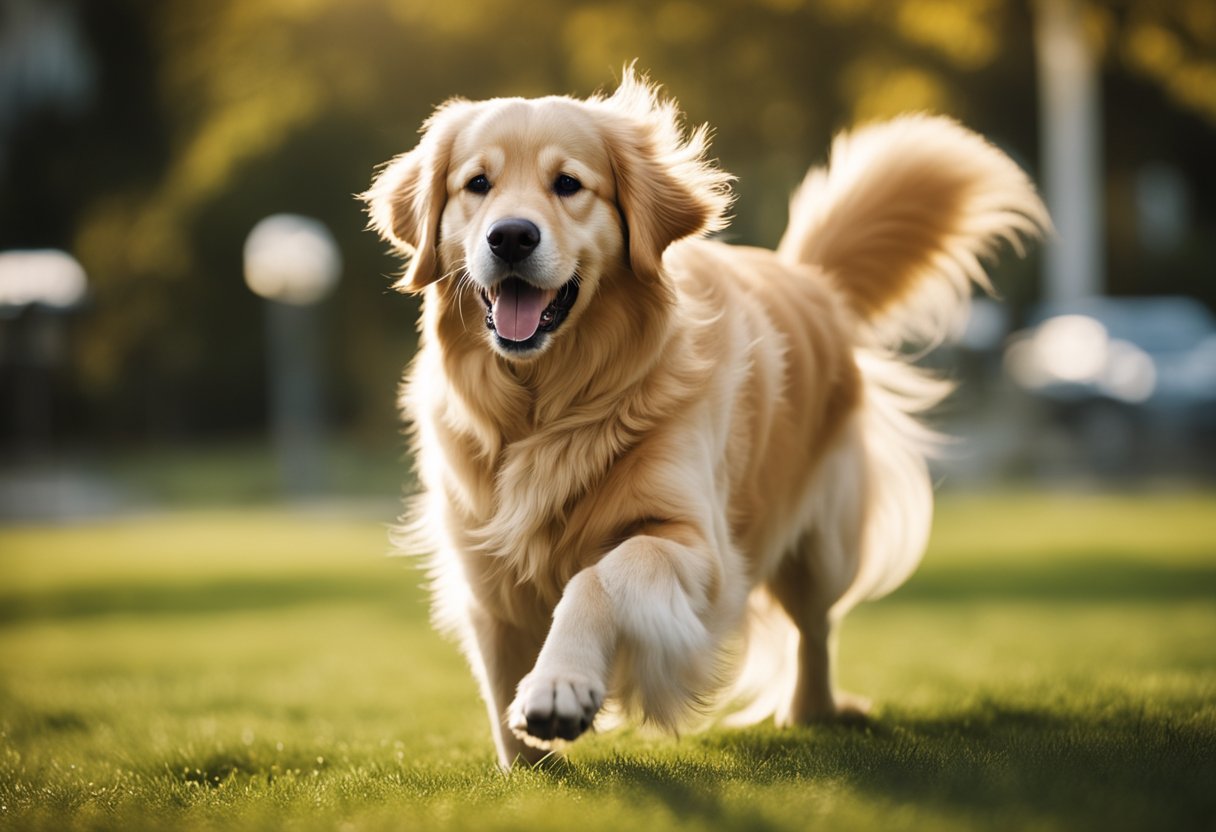
The fullness of a Golden Retriever’s tail is typically realized by 18 months, although the exact time can vary from one dog to another. Proper grooming plays an essential role in the development of a fluffy tail. Regular brushing is important to maintain the tail’s appearance and overall health, while trimming or shaving is discouraged as it can interfere with the natural growth pattern of the fur.
Key Takeaways
- Golden Retriever tails begin to fluff up at around three to four months old.
- Full fluffiness is usually achieved by the time they turn 18 months.
- Regular grooming is vital for the healthy development of a fluffy tail.
Breed Characteristics of Golden Retrievers
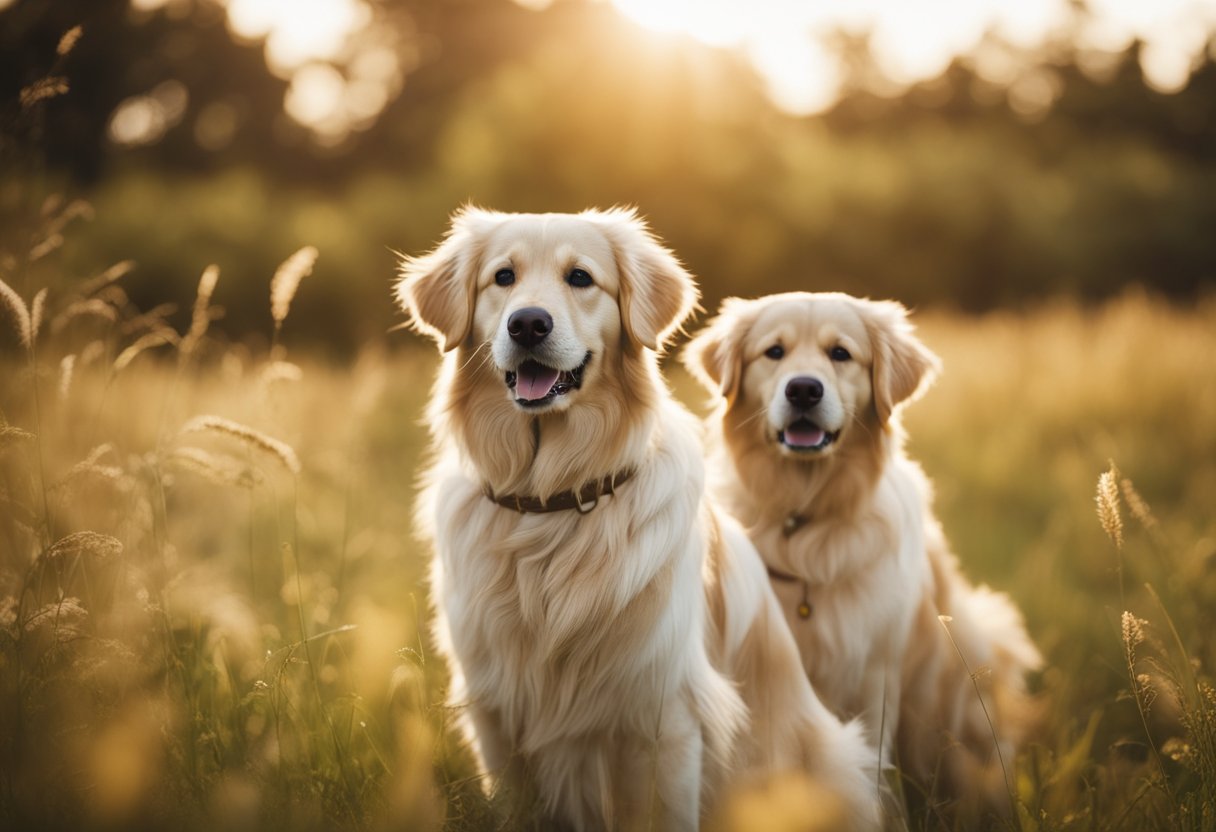
Golden Retrievers are known for their friendly disposition, gorgeous long coats, and adaptability. This section delves into the various facets of the breed, including history, physical characteristics, temperament, health considerations, and breed standards.
Origins and Breed History
The Golden Retriever breed originated in Scotland during the 19th century. They were initially bred by Sir Dudley Marjoribanks, also known as Lord Tweedmouth, aiming to create a skilled retriever suited to the Scottish climate, terrain, and available game. They trace their lineage back to the now-extinct Tweed Water Spaniel, the Newfoundland, and the Irish Setter.
Physical Traits
Golden Retrievers are a medium to large-sized breed, commonly recognized for their long fur and dense double coat which can range from straight to wavy. The undercoat is water-repellent and perfect for their love of water and outdoor activities. Their coat colors can vary from light to dark golden shades, and they require regular grooming to maintain coat health.
Personality and Behavior
Golden Retrievers exhibit a friendly, reliable, and trustworthy personality. They are patient and gentle, making them an incredibly popular breed for families. Known for their intelligence and obedience, they are among the easiest breeds to train. Golden Retrievers thrive on companionship and are active and fun-loving.
Health Concerns and Medical Conditions
They are generally healthy, but like all breeds, Golden Retrievers are prone to certain health concerns. Some of the more common medical conditions include hip dysplasia, elbow dysplasia, various heart diseases, and certain types of cancer. Proper care, regular veterinary check-ups, and a healthy lifestyle can mitigate many of these risks.
Breed Standard Look
The breed standard for Golden Retrievers, set by kennel clubs like the AKC, describes them as symmetrical, balanced, active, powerful, and with kind expressions. They possess a personality that is reflected in their friendly, shining eyes. The standard emphasizes that their tails are well feathered and carried with a “merry action” which is characteristic of the breed.
Understanding Golden Retriever Coat Development
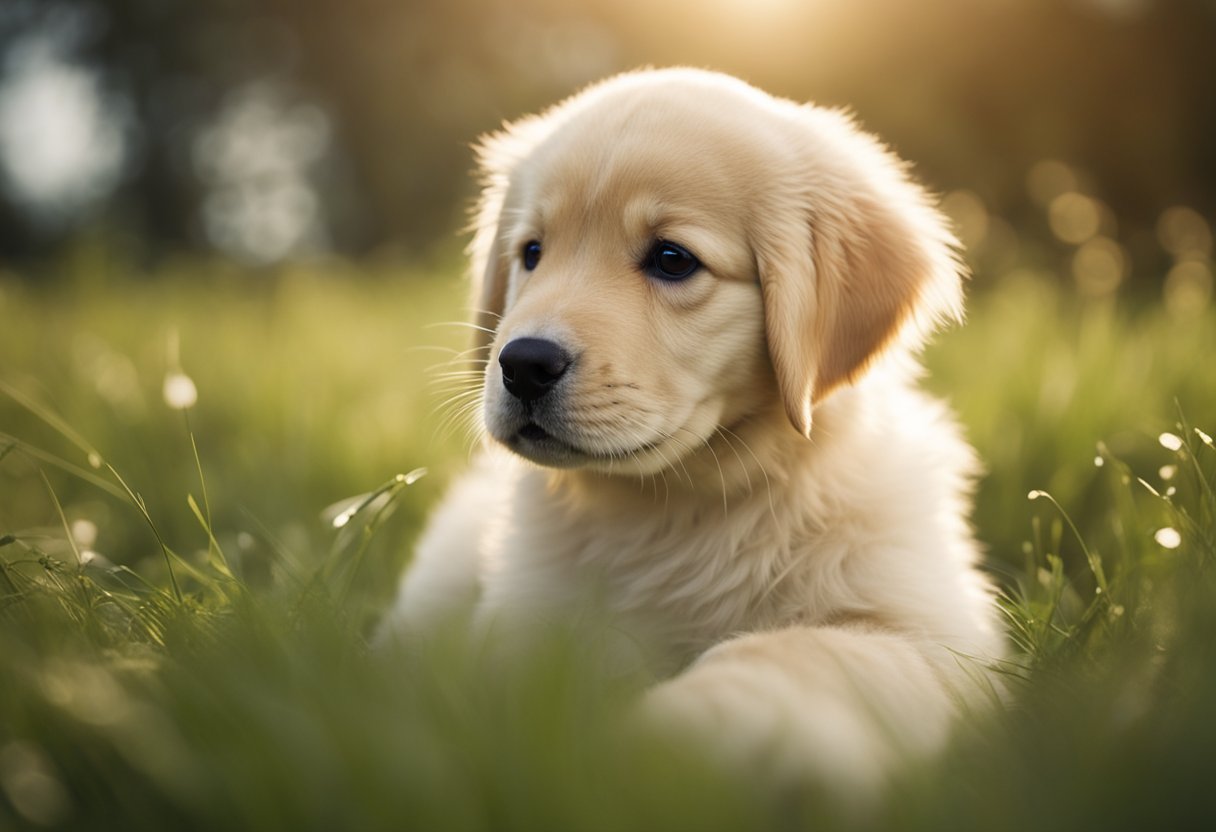
The development of a Golden Retriever’s coat is a gradual process that involves distinct stages of growth, influenced by genetic factors and nutrition, ultimately affecting both appearance and health.
Importance of Coat
The coat of a Golden Retriever is not just an aesthetic trait; it serves as insulation and protection. During puppyhood and into adulthood, the condition of the coat can signify overall coat health.
Stages of Coat Growth
Golden Retrievers experience several coat stages as they age. Initially, puppies sport a soft puppy fluff. At around 3-6 months, a noticeable transition begins as longer fur and the undercoat start to develop, particularly at the tail, showing early signs of feathering. By 12 months, most will display a full adult coat.
Genetic Factors Influencing Coat
The texture, density, and growth pattern of a Golden Retriever’s coat are heavily influenced by genetics. Specific genes are responsible for the rich golden color and the lush double coat that is characteristic of the breed.
Influence of Diet and Nutrition on Coat
Nutrition plays a critical role in coat health. A diet rich in proteins, vitamins, and minerals is essential for robust coat growth. Omega-3 fatty acids are particularly important in fostering a shiny and healthy coat.
Care and Maintenance of a Fluffy Tail
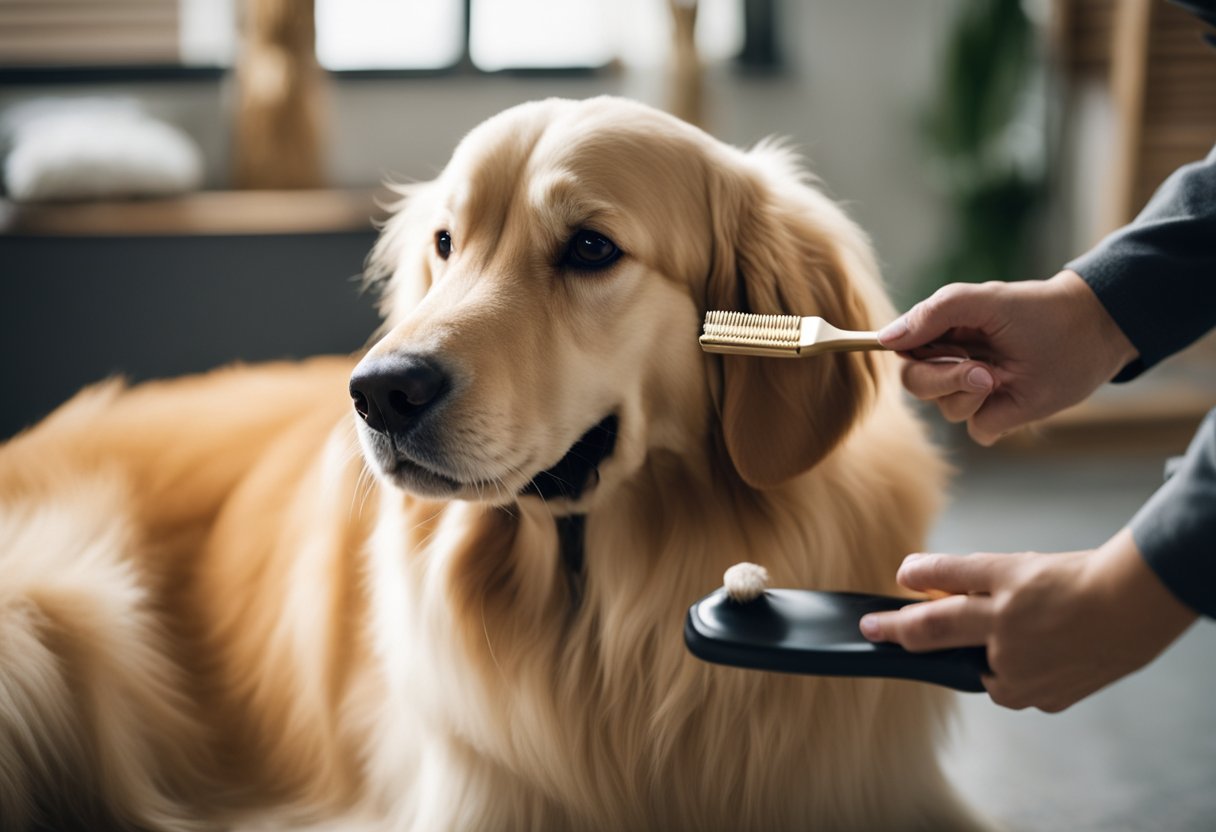
Maintaining a Golden Retriever’s fluffy tail requires consistent grooming and awareness of potential issues. Proper care not only ensures the tail remains aesthetically pleasing but also supports overall tail health.
Regular Grooming
Grooming tools are essential for keeping a fluffy tail in prime condition. Utilizing a high-quality brush, Golden Retriever owners should brush the tail at least twice a week to prevent mats and tangles. A comb may also be helpful for gently working through knots. During brushing, inspect for signs of hair loss or thin tail, which could indicate health issues.
Dealing with Common Tail Issues
A fluffy tail may encounter problems such as parasites, infections, or irritations. Early detection is key, so while grooming, look for any abnormalities or signs of allergies. Should any issues arise, it’s important to clean the affected area with a mild, dog-appropriate soap and warm water. For persistent issues, a consultation with a veterinarian is recommended.
Exercises for Healthy Tail
Exercise plays an indirect yet vital role in the maintenance of a fluffy tail. Adequate physical activity ensures good circulation, which contributes to healthy hair growth. Activities like swimming can help maintain a fluffy and full tail, but after such exercise, owners should rinse off any chlorine or salt to prevent dryness and irritation.
Professional Care Tips
Occasionally, a professional groomer’s expertise can be invaluable, especially for learning the right grooming techniques and identifying the best grooming tools. They can also advise on the right types of oils and other products that help maintain the sleekness and health of the tail’s coat. If a fluffy tail requires trimming to tidy up, it should always be executed by a professional to maintain the correct shape and appearance.
Details on Golden Retriever Tails
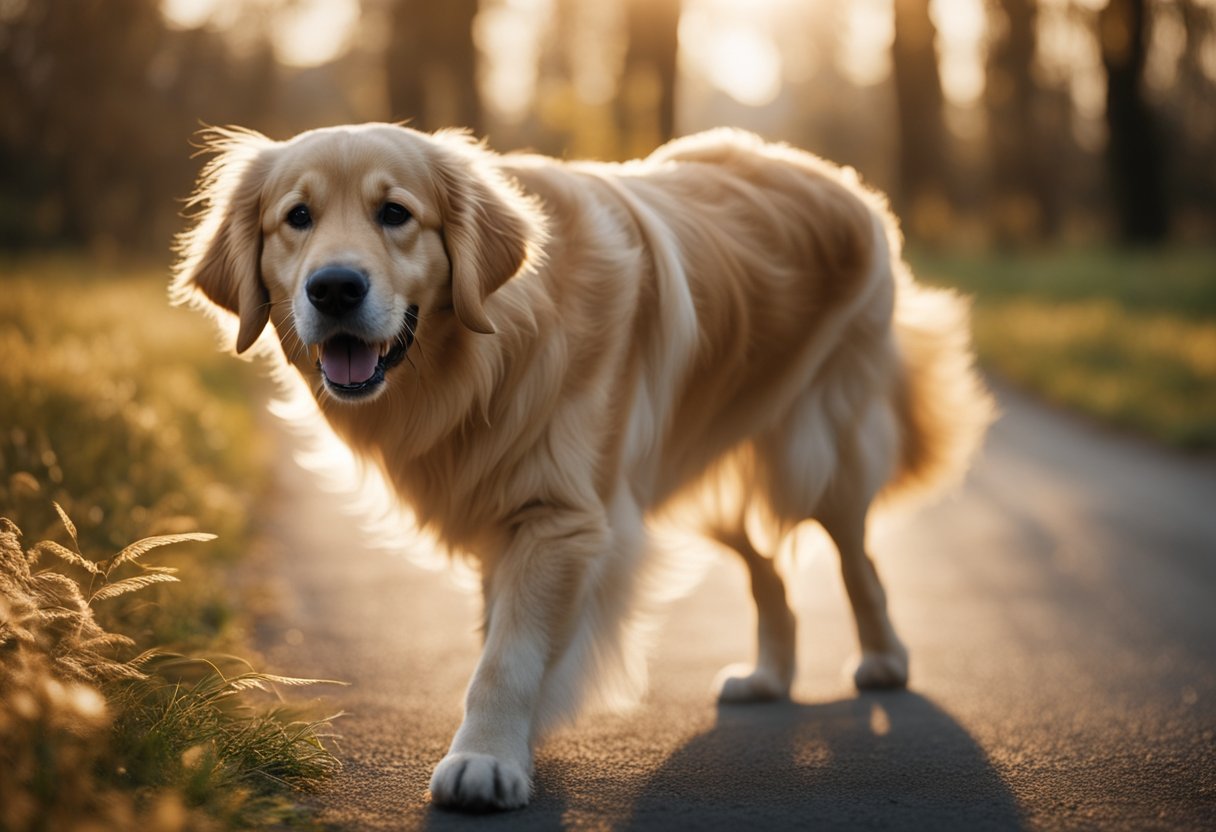
Golden Retrievers are famous for their luxurious tails. This section examines the development and characteristics of these distinct tails, which range from their fluffy appearance to crucial factors affecting their health and growth.
Specifics of the Golden Retriever Tail
The tail of a Golden Retriever is an extension of the spine and ends in a plume-like feature known as feathering. This tail is more than just eye-catching; it also plays a significant role in balance and communication.
When to Expect Fuller Tail Growth
Golden Retrievers typically begin to show fluffier tails around the four-month mark. They should have a fully developed, adult coat—which includes a fluffy tail—by approximately 18 months of age. Their tails will continue to fill out and mature, often reaching full feathering between their second and third year.
Why Tail Fullness May Vary
Variations in tail fullness can be due to several factors such as genetics, diet, and exercise. External factors like stress, hormonal imbalances, and seasonal changes can also influence shedding and overall coat health. Proper nutrition and consistent care play a pivotal role in the development of the tail’s iconic fluffiness.
Tail Function and Health
A healthy Golden Retriever tail should appear long and straight with a slight upward arc. It shouldn’t just look good; it also indicates the dog’s emotional state and helps in heat dissipation. To avoid issues such as cold tail, infections, or impact on tail function, maintain regular grooming and vet checks to ensure optimal tail and overall coat health.
Beyond the Tail: Overall Golden Retriever Care
Proper care of a Golden Retriever involves meticulous attention to their diet, grooming needs, exercise regimen, and health check-ups. These practices ensure a healthy coat, maintain optimal weight, and contribute to overall well-being.
Diet and Nutrition Essentials
Golden Retrievers require a balanced diet rich in protein to support muscle development. They benefit from a mix of vitamins and minerals for maintaining a shiny coat and overall health. Incorporate high-quality dog food that meets their needs for vitamins A and E, and omega fatty acids which are vital for coat health.
- Protein: Essential for muscle maintenance
- Vitamins: Support immune function
- Minerals: Ensure bone health
Exercise Requirements and Benefits
Daily exercise is crucial for Golden Retrievers to keep them at an ideal weight and prevent health issues. A combination of walks, runs, and playtime contributes to their mental and physical well-being. Additionally, regular activity helps in spreading natural oils throughout their coat, ensuring it remains healthy and lustrous.
- 30-60 minutes of exercise daily
- Helps distribute coat oils evenly
Grooming for Health and Condition
Regular grooming is essential for a Golden Retriever’s coat health. They require weekly brushing to prevent matting and to remove loose fur, especially during shedding seasons. Occasional bathing with dog-specific shampoo preserves natural oil levels and keeps the skin healthy.
- Weekly brushing
- Bathing every couple of months or as needed
Veterinary Care for Lifelong Health
Consistent veterinarian visits for check-ups and vaccinations are key to a Golden Retriever’s overall health. Vet visits help in early detection of issues and maintaining up-to-date health records. Preventive care, such as flea and tick treatments, is also part of key maintenance practices.
- Annual check-ups
- Up-to-date vaccinations
Environmental and Seasonal Adaptations
Golden Retrievers adjust to seasonal changes with proper care. In the heat, they need shade and water to prevent overheating, while in the cold, they may benefit from protective wear during walks. Awareness of environmental factors plays a role in the well-being of these adaptable dogs.
- Adequate shelter from heat or cold
- Access to water, especially in hot seasons
Frequently Asked Questions
Golden Retrievers are admired for their beautiful, fluffy tails which typically develop as they grow. This section answers questions about the development and care of their distinctive coat.
At what age does a Golden Retriever’s coat fully develop?
A Golden Retriever’s coat generally reaches full maturity by the time they are around 18 months old, with their tails gaining full fluffiness during this period.
How can I tell if my Golden Retriever has a coat problem?
Signs of a coat problem in Golden Retrievers may include excessive shedding, bald spots, or skin irritation. If these symptoms are noticed, one should consult a veterinarian for proper diagnosis and treatment.
What factors contribute to the fluffiness of a Golden Retriever’s tail?
The fluffiness of a Golden Retriever’s tail is influenced by genetics, nutrition, overall health, and grooming practices.
Are there any supplements to enhance Golden Retriever hair growth?
While there are supplements marketed for enhancing hair growth in dogs, it’s essential to consult with a vet before adding any to a Golden Retriever’s diet to ensure they are suitable and safe for the individual dog.
What are common signs of thinning hair in Golden Retrievers?
Thinning hair in Golden Retrievers can manifest as noticeable hair loss, a less dense coat, or visible patches of thinner fur, typically indicating health issues or nutritional deficiencies.
How does a Golden Retriever puppy’s coat change as it matures?
A Golden Retriever puppy’s coat will transform from being soft and downy to a denser, thicker, and fluffier adult coat as they mature, with noticeable changes starting around three to four months of age.
